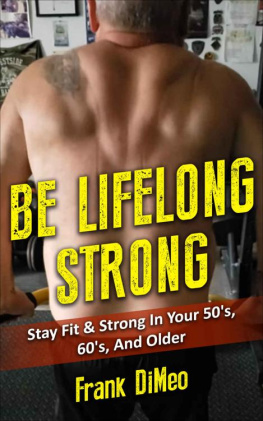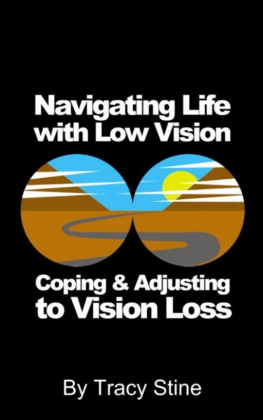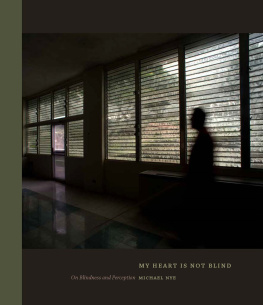


Copyright 2015 by Philip F. DiMeo
All rights reserved. No portion of this book may be reproduced or transmitted in any form whatsoever, including electronic, mechanical or any information storage or retrieval system, except as may be expressly permitted in the 1976 Copyright Act or in writing from the publisher.
Requests for permission should be addressed to:
New Horizon Press
P. O. Box 669
Far Hills, NJ 07931
Philip F. DiMeo
Binoculars: Masquerading as a Sighted Person
Cover design: Charley Nasta
Interior design: Scribe Inc.
Library of Congress Control Number: 2014950536
ISBN-13 (eBook): 978-0-88282-494-9
New Horizon Press
19 18 17 16 15 1 2 3 4 5
T his book is based on the authors research, personal experiences, interviews and real life experiences. In order to protect privacy, names have been changed and identifying characteristics have been altered except for contributing experts.
For purposes of simplifying usage, the pronouns his/her and s/he are sometimes used interchangeably. The information contained in this book is not meant to be a substitute for professional evaluation and therapy with mental health professionals.
A s a kid, I devoured books and stories about heroic animals. I never doubted the life-saving potential of our sweet family dog; Gingers imaginary feats were extraordinary, her devotion unparalleled. But like most childhood notions, wondrous dreams of a transcendent human-animal bond faded and disappeared as I grew into adulthood. Then one damp and dreary afternoon during my senior year of college, I was reminded of those ideals and realized they were not just fantasy; I had my first encounter with a guide dog team on the Miracle Mile in downtown Chicago.
My recollection of that day is vivid. I had hurried out to grab lunch between classes, brooding about final exams and aiming for a cheap sandwich shop across Michigan Avenue. I fidgeted at the red light as horns blared and cars splashed past. Unexpectedly, the delicate and melodious jingle of dog tags cut through the soggy urban hum. A hefty, butter-colored Labrador retriever trotted toward the corner sporting a tan leather harness. A long handle rose from the strap across the dogs sturdy shoulders, and a man held the well-worn grip. The two weaved through pedestrians to stop at the curb alongside me, and the man reached down to scratch behind the dangling ears.
Forgetting my haste, I was both enthralled and alarmed. How will this dog know when its safe to cross? Can he read the light? Should I help? Just as I made up my mind to speak, the light changed to green and the man confidently commanded the dog forward. My help was not needed. They crossed briskly to the other side and disappeared into a sea of umbrellas, leaving me in a state of awe.
The next time I saw a guide dog was four years later at the start of my career with Guide Dogs for the Blind, Inc. I learned what I didnt know that day in 1990: the guide dog did not decide when to cross the street. Instead, the man made the decision based on audible traffic flow, and the dog may have intelligently disobeyed his command if it wasnt safe to proceed. The flawless street crossing I had witnessed was a glimpse of the beautiful and complicated partnership that begins with a carefully bred, raised and trained guide dog, and a person who has established confidence and efficiency in independent travel.
At Guide Dogs for the Blind, an organization founded in 1942 primarily for servicemen blinded in combat in World War II, formal schooling to develop a guide dogs skills begins when the dogs are around a year-and-a-half old. But they are molded into well-mannered members of society from the start. As puppies, these guide dogs are carefully mentored and socialized from a young age while in the kennels on campus. At around eight weeks, each of the pups goes to the home of a volunteer puppy-raising family that teaches appropriate house behavior and shapes them into responsible young adults. Guide dog puppies accompany their raisers everywherefrom the boardroom to the classroom to the shopping malllearning how to be calm and courteous in public settings. The dogs are then ready to return to the Guide Dogs campus for formal training.
The formal stage of training, using positive reinforcement methods, begins in a simple way. Using treadmill training with praise, a clicker and food reward, dogs are taught how to lead while wearing the Guide Dog harness. Complexity of training progresses in stages. Dogs develop the ability to lead their instructors in a straight line from point A to B along a sidewalk while maneuvering around obstacles along the way, to stop for curbs and changes in elevation such as steps or potential hazards, and to respond to directional commands (Left and Right). Throughout their education, the guide dogs learn to safely navigate a variety of environments from quiet, unpaved country roads to city subway platforms to college campuses to bustling urban centers. Proficiencies are tested with the Guide Dog Mobility Instructor under blindfold at several stages, before they are deemed ready to be paired with a student who comes to campus for a two-week course of instruction. The student is then shown the skills necessary to travel safely and efficiently with a guide dog, methods that they bring home after graduation to begin the process of growing into a smoothly working team. Prerequisites for this program include established mobility skills; a guide dog handler must already possess the confidence and independence to direct and manage the dog along a route, including making street-crossing decisions.
Gaining this type of independence can take tremendous courage and perseverance. Over the past two decades as a Guide Dog Mobility Instructor, Ive met and worked with people who have overcome incredible odds and unfathomable challenges to regain or retain their independence without vision. The author of this book, Phil DiMeo, is one of them.
I met Phil in 2004 when he returned home from training, newly graduated with his first guide dog, Ladonna. Most guide dog teams encounter some hurdles along the way, especially during the first year; Phil and Ladonna were no exception. I watched them evolve as a team from their early days of establishing a bond and learning how to communicate with one another, to the later years of Ladonnas integral role in Phils travels, social life and softball championships.
I am amazed by Phils accomplishments, his abiding humor and unflappable courage. A compelling, vibrant individual, Phils story offers encouragement through strength of will and a gritty approach to lifes predicaments.
I have worked with hundreds of guide dog teams. Each pair has taught me valuable lessons about determination and self-awareness, partnership and empathy. Phils engaging account of his own journey allows readers a chance to share in these insights and learn from his mistakes. His inspiring story illuminates his gradual migration from a devastating loss and a seemingly debilitating diagnosis to the effortless navigation of a smooth and skillful crossing on the Miracle Mile.
Lauren Ross
Field Service Manager/Guide Dog Mobility Instructor
Next page






